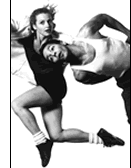|
Dance
Redefined,
Page 4
Growing
Pains
Buying the building ushered in great changes for ODC/San Francisco,
not all of them easy. Many of the original company members left.
A professional staff was hired for the first time. And the structure
of the company changed from a pure collective to its current, more
hierarchical one.
“We realized as we got bigger that the full collective participation
was too cumbersome,” Way says. “A day-long meeting once
a week to decide what you’re doing the other four days ceased
to work.” Says Nelson, “We tried to be equal; we weren’t.
Now we’re equally valued; we don’t have equal power.”
ODC’s dancing style evolved as well. “Our original artistic
inclinations were almost entirely based around thinking rather than,
say, dancing,” Way says. “It was about art-making. We
were not very interested in technical virtuosity or elegance or
refinement. It wasn’t so interesting to point your toes. People
had been doing it for hundreds of years.” But as ODC developed
its kinetic vocabulary, the company began daily training in modern
dance and ballet. Dance critic Monica Segal responded to this trend
by suggesting it was America’s first post-postmodern dance
company.
The founding members’ commitment to the company allowed them
to weather change and stay artistically vital. “ODC is a tremendous
group,” says Professor of Music Composition and Music Theory
Randolph Coleman, who worked closely with ODC at Oberlin in the
1970s and now chairs the Conservatory composition department and
directs its contemporary music division. “The numbers of dance
companies that have started and failed in the last 30 years are
legion. ODC is a community, interlaced with relationships with filmmakers,
theater people, musicians. Brenda is the vortex of the whole thing.
She’s bright, committed, one of the best fundraisers on the
West Coast, and has a huge amount of energy.
“But one of her real strengths is that she doesn’t overpower
the company with her own energy,” notes Coleman. “If others
are as motivated as she is, she gives them room. Brenda develops
her own pieces, and others do their pieces. It’s unusual for
a company to function that openly. Brenda excels in constituting
that environment, which is not predetermined ideologically. That
has been the identity of ODC—their ability to morph, based
on the continuity of those three people [Way, Nelson, and Okada.]”
Way likens this three-decade partnership to an old marriage. “The
continuity allows you to speak shorthand, to continue to evolve
your value structure together, because you share the experience,”
she says. “You don’t need to keep re-inventing the beginnings.
I think of families who have strong feelings about family. It’s
not that they agree on everything, but they are committed to that
notion, and I feel the same way about this. We’re committed
to a common notion, and then we battle it out as we go along, but
we never question that fundamental commitment.”
Building
a Future Together
At 30, ODC’s vision for the future is like its dancing—both
grounded and expansive. The company is in the midst of buying the
building next door, allowing it to double floor space, add five
new studios, an additional theater, café, Pilates studio,
and dance injury prevention clinic. The larger digs will also enable
them to expand their own programs and provide rental space for other
dance groups.
“I want to make Art Town,” says Way. “I think art
is about values, and I think we can have a contemporary institution
that represents that in a hundred different ways. I want the flow
to be complex, like the community. We’re very isolated, artists.
The struggle is too hard, and it brings out the most fear in people.”
Does Way hope to re-create the heady atmosphere of ODC’s early
days in Warner Gym, with creative work literally flowing out into
the halls? “Yes, I do,” she says. “Only a more complex,
urban version of it. I think that’s what we’ve always
been trying to do. I imagine people coming out of class when there’s
a showing, and you just walk in—and then you go to the café,
and you talk to people who are working on another piece next door.
I guess I’m still an idealist.”
ODC is cultivating that idealism in a new generation. Nelson, who
just three years ago retired from dancing in the company, continues
to direct ODC’s education program and seven years ago founded
the ODC Dance Jam, a children’s dance ensemble. Because the
Dance Jam members are growing up and will soon move on, a new group
of 9- and 10-year-olds called the Jellies began rehearsals this
fall.
“Some of the kids are gravitating toward ballet, because they’re
at a time in their lives where a lot of things are changing, and
they just want to lock onto something secure,” says Nelson.
“But this is not how the world works. I want to say, ‘Know
yourself in Messy-Land. Know yourself when you’re not in control
and trying to find a solution that’s not clear.’ The nature
of making art is to reveal new territories, new visions and perspectives.
And in order to do that, in some ways, nothing can be the same.”
Okada agrees. Today, she co-directs the Dance Jam and is director
of the ODC School, which offers classes for both children and adults.
“All those things that we believed in during our 20s—creating
community, being an ensemble, being individuals, appreciating training,
seeing other people perform—we’re building that right
in for kids who are starting at age 6.”
Like so much of ODC’s vision, this idealism is not just about
dancing, or even art-making. It’s about learning to revel in
ambiguity, to savor its taste, and employ it. As ODC ripens into
life after 30, and uncertainty becomes ever more abundant, that
can only be a sign of hope.
Elizabeth
Chur works in communications for a homeless service agency
in San Francisco. She studied development of free press in Eastern
Europe as a Thomas J. Watson Fellow, and has also written for The
Chicago Tribune, The Seattle Times, and sidewalk.com.
View
Page 1 | 2
| 3 | 4
of Dance Redefined
|


